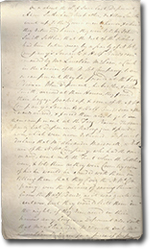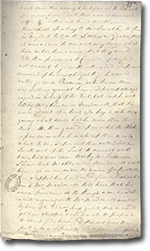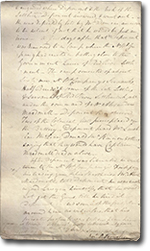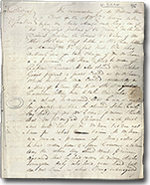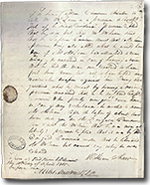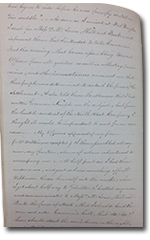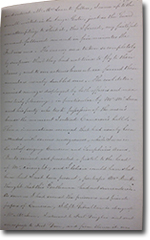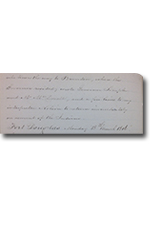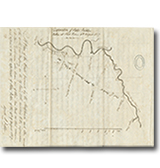Spotlight: The Hudson's Bay Company Archives in Words and Images
Seven Oaks & HBCA Records: 1816-2016
- Part I
- Part II
- Part III
- Part IV
- Part V
Part I: Background of Seven Oaks
On 8 January 1814, Governor Miles MacDonell issued what came to be known as the Pemmican Proclamation. The proclamation, in large part, triggered years of hostility among the the two main actors of the Canadian fur trade: the Hudson’s Bay Company (HBC) and the North West Company (NWC). Over the next few years hostilities continued to escalate and on 19 June 1816 the two sides met in a violent confrontation at a place called Seven Oaks, present-day neighbourhood of West Kildonan, Winnipeg.
In recognition of the 200th anniversary of the events at Seven Oaks, the Hudson’s Bay Company Archives is highlighting records that document the era known as the “Pemmican Wars” in a series of Spotlights featuring records from our holdings. These records were mainly written from the point of view of Hudson’s Bay Company servants who eye-witnessed these events.

enlarge image
Part II: Stirrings and unrest at Red River
Featured in this Spotlight – Part II of Seven Oaks in HBCA Records: 1816-2016 – are the depositions, or sworn out-of-court testimonies, of George Sutherland and William Shaw. These and other depositions were taken in 1815 upon the order of Thomas Douglas, the 5th Earl of Selkirk, as a means to gather evidence against North West Company (NWC) men for their actions against Red River settlers, which included forecefully evicting settlers from their homes and destroying many of their dwelling places.
George Sutherland and his family had been Red River settlers at the time of the alleged NWC activities. In his deposition, pictured below, Sutherland recounts the events leading to his eviction, explaining that in early April 1815, he received a note from Captain Duncan Cameron of the “Voyageur Corps” demanding he “give up [his] musket in the King’s name”. Sutherland refused to hand over his gun and as a result, NWC men arrived to seize his musket by force and remove him and his family to a make-shift prison at an encampment on the Frog Plain (present-day neighbourhood of West Kildonan in Winnipeg). The deposition also notes witnesses who affirmed that Sutherland’s “property was taken from him by force.”
The second deposition is the “examination of Mr William Shaw”, pictured below. Shaw had been employed as a NWC clerk in the Spring of 1815 and had participated in the forced evictions of Red River settlers. In the deposition, Shaw is being questioned for his involvement in the capture and imprisonment of Alexander McLean, the “Chief settler in Red River Settlement”.
When asked by his examiners – “By what authority did you take charge of Mr McLean as a prisoner!” Shaw replied “by order of Captain Cameron”. Shaw goes on to specify the details of the Captain’s orders and the events that followed.
To search for descriptions of these and other depositions created at the time, search our online database, called Keystone, using the keywords “depositions and disturbances”.
Part III: Rumour has it: HBC and the Capture of Fort Gibraltar, 17 March 1816
After the Pemmican Proclamation in 1814, tensions escalated between the Hudson’s Bay Company (HBC) and the North West Company (NWC). HBC’s Fort Douglas and NWC’s Fort Gibraltar were both on the banks of the Red River, near the Forks. Colin Robertson, who was in charge of Fort Douglas at this time, recorded his thoughts and observations in several personal diaries. By looking at his diaries, one can see the increase in hostility between NWC and HBC, particularly when rumours started to fly.
Robertson’s diaries are a treasure-trove of historical information, recording details of the daily activities at the forts, interactions with Chief Peguis and other Indigenous peoples of that time and place, altercations with the NWC, and names of the men and women in the forts and colony. His diaries also describe HBC’s capture of Fort Gibraltar in 1816.
By spring 1816, Robertson recorded rumours that the NWC would attempt to scare the settlers away again, like they had attempted in 1815, and this time for good. However, it was not just rumours that were worrying HBC officials; Robertson also noted that more provisions and men were filtering into Fort Gibraltar, the closest NWC fort to the Red River Settlement, and he assumed the worst.
On 17 March 1816, Robertson decided that action was required to protect the settlers. That evening he armed himself and twelve others, quietly marched to Fort Gibraltar, quickly surrounded the sleeping NWC men and took control of the fort. According to Robertson’s journal, the NWC men were taken completely by surprise and were captured even though NWC’s numbers were nearly double that of HBC.
You can read Robertson’s observations of the capture of Fort Gibraltar in the images below.
After the capture of Fort Gibraltar tensions between HBC and NWC only increased thereafter. HBC maintained possession of Fort Gibraltar and it eventually came to be known as Upper Fort Garry.
To learn more about Colin Robertson’s diaries, search Keystone using the keywords “Colin Robertson diary”.
Part IV: Peter Fidler and Brandon House: Along the Trail to Seven Oaks
The weeks before 19 June 1816 witnessed several events that set the stage for the encounter at Seven Oaks. On 1 June, on their way to Red River, Cuthbert Grant’s party of 48 North West Company servants, Metis, and Indigenous men forcefully entered the HBC’s Brandon House.
Peter Fidler was the post master at Brandon House at the time. He recounted these events in his Brandon House post journal dated 1815-1816. In it, he describes the first dramatic moments of 1 June:
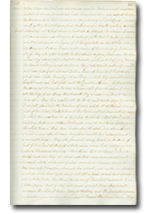
enlarge
“at ½ past noon about 48 Halfbreeds, Canadians, Freemen & Indians came all riding on Horseback, with their Flag flying blue about 4 feet square & a figure of 8 horizontally in the middle, one beating an Indian Drum, and many of them singing Indian songs. They all rode directly to the usual crossing place of the river where they all stopped about two minutes... They all turned suddenly round and rode full speed into our yard – some of them tyed their Horses, others loose & fixed their flag at our Door, which they soon afterwards hoisted over our East Gate next to the Canadian House. Cuthbert Grant then came up to me in the yard & demanded of me to deliver to him all the keys of our Stores, Warehouses etc. I of course would not deliver them up – They then rushed into the House and broke open the Warehouse Door first, plundered the Warehouse of every article it contained, tore up part of the Cellar floor, & cut out the Parchment windows without saying for what this was done or by whose Authority.”
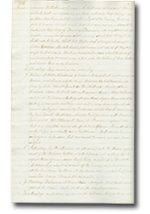
enlarge
Grant’s men stayed for seven days, stripping Brandon House of all its provisions and the private property of its employees, and setting fire to many of the buildings. The outnumbered HBC servants were forced on to the plain and received shelter from the nearby Indigenous people. On 7 June, Grant’s party left, continuing east towards Red River.
Peter Fidler’s Brandon House post journal gives a detailed first-hand account of this dramatic event in a forum usually reserved for brief and mundane daily accounts. Post journals recorded the daily events and business transactions at the Hudson's Bay Company's fur trading posts, and were used by the Governor and Committee in London to make decisions regarding the viability of post operations. However, when out of the ordinary events happened at the posts, the journals are valuable tool in understanding significant historical moments.
A year later, Fidler gave a deposition to William Coltman, special commissioner to an inquiry regarding the events at Seven Oaks, called by the British Government.
In July 1817, Fidler surveyed the cart route taken by Cuthbert Grant and his party after they left Brandon House as they travelled from Catfish Creek (now Omand’s Creek) to Frog Plain. Fidler had been accompanied by Antoin Descharme, who had driven one of the carts, along with other eye witnesses.
Fidler’s deposition contains the results of this survey, along with a sketch plan showing the route. Based on his survey findings, Fidler editorializes that Grant’s men could have chosen a more easily passable route that would have prevented the fateful encounter.
To find more records about Brandon House or Peter Fidler, search Keystone.
Part V: 19 June 1816, on the Frog Plain
On 19 June 1816, a violent confrontation occurred at Seven Oaks, present day West Kildonan in Winnipeg. Cuthbert Grant and a group of approximately fifty Métis and North West Company men were travelling north towards Lake Winnipeg with provisions of pemmican for North West Company traders.
As they were journeying across the plains in the vicinity of the Forks, they were spotted by the lookout at Fort Douglas and intercepted by Robert Semple, Governor of the Red River Settlement, and a party of twenty-eight HBC men. Grant and his men had the advantage of being on horseback and greater in number and as a result, the HBC side took the higher number of casualties.
The violent clash left Governor Semple dead in addition to 20 HBC men and 1 Métis man.
In 1823, John Halkett wrote a letter to Robert Pelly with the idea of putting a monument over the grave of Governor Semple. The letter included a draft, shown below, of what was to be etched on the monument. Along with Governor Semple are the names of 20 HBC men “who fell mortally wounded” on that day.
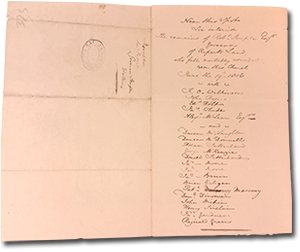
enlarge
letter from John Halkett to Robert Pelly, 20 August 1823,
HBCA A.10/2 fo. 373.
See past features in the Spotlight Archive.



